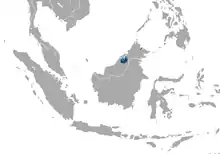Bornean pygmy shrew
The Bornean pygmy shrew (Suncus hosei) is a species of shrew in the family Soricidae. It was named for zoologist Charles Hose.
| Bornean pygmy shrew | |
|---|---|
| Scientific classification | |
| Domain: | Eukaryota |
| Kingdom: | Animalia |
| Phylum: | Chordata |
| Class: | Mammalia |
| Order: | Eulipotyphla |
| Family: | Soricidae |
| Genus: | Suncus |
| Species: | S. hosei |
| Binomial name | |
| Suncus hosei (Thomas, 1893) | |
 | |
| Bornean pygmy shrew range | |
Distribution
This shrew is endemic to the international island of Borneo, particularly in northern Sarawak and northeastern Sabah states of Malaysia. It may be more widespread and occur in the nation of Brunei, and in northern Kalimantan province of Indonesia.
Its natural habitat is subtropical and tropical dry forests. It is often listed as the Etruscan shrew (Suncus etruscus) which is native from Europe and North Africa through Southeast Asia, but they are distinctly different species.
Conservation
It was listed as an IUCN Red List Vulnerable species since 1996, until changed to a Data Deficient species in 2008.
The exact threats are unknown. If it is forest dependent, it is threatened by habitat loss from: habitat conversion to agricultural plantations, especially for palm oil; logging; and fires. It is not known, from botanical collecting, to have any protected populations within nature reserves or parks of the three countries.
References
- Lunde, D. & Ruedas, L. (2008). "Suncus hosei". IUCN Red List of Threatened Species. 2008. Retrieved 6 July 2010.old-form url Database entry includes a brief justification of why this species is of data deficient.
